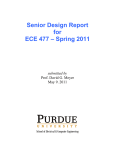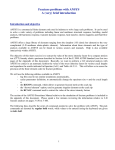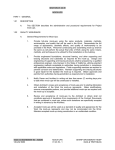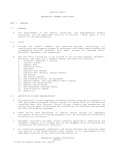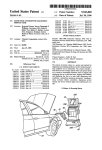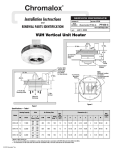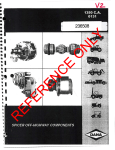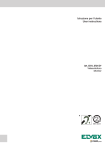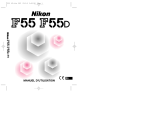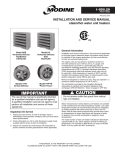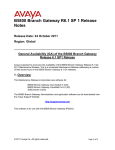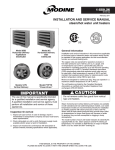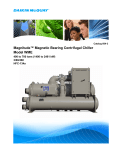Download man mm 20
Transcript
US005764579A United States Patent [191 [11] Patent Number: McMasters et a]. [45] [54] SYSTEM FOR CONTROLLING LABORATORIES WITH FUME HOODS Date of Patent: 5,764,579 Jun. 9, 1998 “NETWORK” by American Auto-Matrix dated Spring/ [75] Inventors: David C. McMasters. Monroeville; David M. Fisher. Pittsburgh; Bruce 1). Arnold. Murrysville. all of Pa. Summer 1989. “SOLO/PX Hood/Lab Control” by American Auto-Matrix dated about Jan. 1989. “Face Velocity Control Systems" brochure by Anemostat. copyright 1984. [73] Assignee: American Auto-Matrix, Inc. “Yamato Clean Benche” product description brochure. “Envirotrak—A Laboratory Air Flow Control System from [21] Appl. No.: 591,541 Anemosta ” dated Aug. 1985. [22] Filed: ‘Total Lab Control for the 90's TLC-90" by Anemostat. copyrighted in 1988. Oct. 1, 1990 [51] Int. Cl.6 [52] US. Cl. [58] B08B 15/02 364/131; 454/59; 454/61; 454/62; 4541340 Field of Search . 364/131. 132. 364/133. 1538145415641. 62. 340 [56] Attomey Agent, or Firm—Reed. Smith. Shaw & McClay U.S. PATENT DOCUMENTS 4,557,184 4,706,553 4,741,257 4,773,311 5,090,303 5,090,304 5,092,227 Primary Examiner-Reba I. Elmore Assistant Examiner-Thomas E. Brown References Cited 4,040,042 4,528,898 4,160,407 Information Disclosure Statement/Declaration of Linda Diss and attachments thereto. Information Disclosure Statement/Declaration of Richard Fish and attachments thereto. [57] 8/1977 Mayer. 7/1985 7/1979 Duyin 12/1985 11/1987 5/1988 9/1988 2/1992 2/1992 454/61 454/61 454/61 454/59 454/56 454/58 454/59 454/59 3/1992 UI'HER PUBLICATIONS “SOLO/FX. Preliminary Production Description” dated Nov. 14, 1988. ABSTRACT A system for controlling laboratories having fume hoods comprising a network along which information is carried. The system is also comprised of a controller in contact with the network for receiving information from and providing information to the network. Additionally. the system is comprised of means for sensing a laboratory‘s state. The sensing means is disposed in each laboratory. There is additionally a microprocessor disposed in each laboratory for receiving information concerning the laboratory from the respective sensing means and the controller in order to maintain the laboratory in a predetermined state. and to provide information about the laboratory to the controller. “SOLO/PX” by American Auto-Matrix, copyrighted in 1989. 54 Claims, 8 Drawing Sheets 1)8 [l6 CONYRGLLER Rtnursnus MEANS E4 121 I21 LAB 121 Lat LAB man mm MICROPRDCESSUR Tea HICRUPRQCESSUR (22 % 20 HICROPRUCESSOR \zz US. Patent 0 Jun. 9, 1998 Sheet 1 008 5,764,579 ‘)8 [l6 CONTROLLER REQUESTING MEANS i 24 LAB HOOD LAB H00!) $500100 MEANS ,4 20 - MICRUPROCESSOR ~ LAB H000 0000M”, H000 ssnsme 05020‘ H0011 ~44 SENSI 0N. 0500s MEANS MICROPROCESSUR MICROPROCESSUR T22 (22 H6. l ‘ 2° 122 US. Patent Jun. 9, 1998 Sheet 2 of 8 5,764,579 FUHE FIG-2 r82 NICROPROCESSOR FIG. 5 US. Patent Jun. 9, 1998 5,764,579 Sheet 3 of 8 3x A E\bw\%woEZw,235; E23;u m =.\ ¢ INN 3,sump2a!5:? kw?x \ 0. -“ how 5mwvwe 55%?\ss FNE32"nmu US. Patent Jun. 9, 1998 Sheet 4 of 8 U 6ND / /_ .. _ _._ ...\ OA ‘ ‘ I OB l 1 0c 22 OD ENCLOSURE SHEILDED CABLE ° JACKET ca _ 5,764,579 4/ ’ : Ir I I i [A 1 $2)1 I I 1’ [l8 o 82v GNP/C1 M ‘HI‘1-,.M0BULE‘) MOUNTING PLATE conmumcmou I WIRING I ‘ l_] .0 1] ., d- g m ‘1/0 MODULE‘ TM ‘1/0 MODULE‘ PWER supmr? :—a FOUNDATI H ‘II O _ D U H US. Patent Jun. 9, 1998 Sheet 6 of 8 5,764,579 b| Z5wz:2o5)w 4 2.S3g8u.85 45:2%o1:65 ,H Eézi3onaml21:3 : :WZ3EQ m5osm:d2315:M 2:02 .1 mum; 533.2:82:A,255 : Pil E2:35; $5 5“ 53a:mw vHz;I.397E 352: m2 wréuw mm.03. US. Patent Jun. 9, 1998 Sheet 8 of 8 5,764,579 B = 1 f A C = A ‘ B PID DELAY E = MAXIMUM OF A, B, E. 0R D FIG. 8 5,764,579 1 2 SYSTEM FOR CONTROLLING LABORATORIES WITH FUME HOODS FIG. 7 is a schematic representation of a hood control circuit. FIG. 8 is a key. with respect to elements of FIGS. 6 and FIELD OF THE INVENTION 7. de?ning them. The present invention is related to systems for controlling laboratories with fume hoods. More speci?cally. the present DESCRIPTION OF THE PREFERRED EMBODIMENT Referring now to the drawings wherein like reference numerals refer to similar or identical parts throughout the several views. and more speci?cally to FIG. 1 thereof. there is shown a schematic representation of a system 10 for invention is related to a system for controlling laboratories with fume hoods using a network to communicate with a remote controller to control the state of the laboratory. BACKGROUND OF THE INVENTION Laboratories wherein dangerous experiments or processes are performed require protections for the workers and the experiments in the laboratory. One very common protection controlling laboratories 12 having fume hoods 14. The system 10 is comprised of a network 16 along which information is carried. Preferably. the network 16 operates in the half-duplex mode. for instance. with a two-wire RS485 network. The system 10 is also comprised of a controller 18 in contact with the network 16 for receiving information from found in laboratories are fume hoods in which chemical reactions are conducted. The fume hoods have air drawn out of them thus essentially preventing any toxic fumes from escaping the fume hood into the laboratory and threatening the operators. The velocity of air drawn through the fume hood sash is controlled to a value high enough to maintain safety for the operator and low enough to provide non turbulent air for the experiment of process. An additional protection that can be provided is to main tain the static pressure in the laboratory at a lower or higher pressure than the pressure in the surrounding corridors of the building. A lower pressure would prevent contaminants from exiting the laboratory in the case of an accident. A higier pressure would prevent contaminants from entering the laboratory. as is the case in a clean room. Also. and providing information to the network 16. Preferably. the controller 18 includes means 24 for requesting information from each microprocessor 22 about its condition. Preferably. the requesting means 24 requests information from each microprocessor 22 one at a time. 25 Additionally. the system 10 is comprised of means 20 for sensing a laboratory's 12 state. The state of the laboratory is de?ned as. at least. the static pressure and the supply/exhaust differential of the laboratory 12. and also the face velocity of the fume hood 14 in the laboratory. The sensing means 20 is disposed in each laboratory 12. The sensing means 20 preferably includes a static pressure sensor 26. a supply/ exhaust differential sensor 28 and a face velocity sensor 30 disposed in each laboratory 12. as shown in FIG. 2. FIG. 2 is a schematic representation of the laboratory 12. There can control of the laboratory climate is required both for opera tor comfort and for certain experiments or processes where strict temperature and humidity control are necessary. also be included a temperature sensor 32. There are many schemes and apparatuses that provide such control and protection to laboratories. However. 35 There is also a microprocessor 22 disposed in each laboratory 12 for receiving information concu-ning the labo heretofore. there have been no systems that provide for ratory 12 from the respective sensing means 20 and the integrated direct digital control of laboratories. controller 18 in order to maintain the laboratory 12 at a SUMMARY OF THE INVENTION predetermined state. and to provide information about the laboratory 12 to the controller 18. Preferably. the controller 18 and the microprocessors 22 maintain the respective The present invention pertains to a system for controlling laboratories having fume hoods. The system is comprised of a network along which information is carried. The system is also comprised of a controller in contact with the network for receiving information from and providing information to the network. Additionally. the system is comprised of means 45 for sensing a laboratory's state. The sensing means is laboratory 12 in the predetermined state by maintaining their respective static pressure and supply/exhaust differential as well as the face velocity of the hoods 14 of a given laboratory 12. The controller 18 and mitroprocessors 22 preferably disposed in each laboratory. There is additionally a micro opaate in a master slave relationship with the controller 18 processor disposed in each laboratory for receiving infor mation concerning the laboratory from the respective sens The master initiates all communications by sending mes ing means and the controller in order to maintain the being the master and the microprocessor 22 being the slave. 50 sages. Messages are composed. for instance. of data bytes transmitted serially using standard asynchronous data laboratory in a predetermined state. and to provide infor mation about the laboratory to the controller. frames. These data frames can consist of one start bit. eight data hits. no parity bit. and one stop bit. BRIEF DESCRIPTION OF THE DRAWINGS In the accompanying drawings, the preferred embodi The master and each slave share the same network 16 for 55 each slave must be able to enable/disable their transmitters (not shown). so as not to interfere with other slaves’ trans missions. The transmitter enable/disable should be con trolled such that the carrier enable is switched off concur ments of the invention and preferred methods of practicing the invention are illustrated in which: FIG. 1 is a schematic representation of a system for controlling laboratories having fume hoods. rently with the end of the final stop bit of any transmission. The master arbitrates when a given slave may respond with the simple rule that a slave only transmits in response to a FIG. 2 is a schematic representation of a laboratory. FIG. 3 is a schematic representation of a microprocessor. FIG. 4 is a schematic representation of the network message uniquely directed to it. See PUP guidelines (A configuration. FIG. 5 is a schematic representation of a module. FIG. 6 is a schematic representation of the laboratory control transmitting and receiving (half-duplex). The master and 65 document entitled “PUP Protocol Guidelines" is available from American Auto-Matrix. Inc. Please contact the PUP Protocol Committee and request Version 6.) for an example of a protocol that can be used in ?re system. 5,764,579 3 4 In the operation of the preferred embodiment. a micro processor 22 is disposed in each laboratory 12. as shown in FIG. 3. FIG. 3 is a schematic representation of the micro processor 22. The microprocessor 22 is comprised of a fuse 32 which protects the microprocessor 22 from electrical cates that the microprocessor 22 is operating properly. A third led 74. when on. indicates that the microprocessor 22 is transmitting data to the controller 18. A fourth led 76 indicates when the microprocessor 22 is receiving data. There is a jumper block 78 with two pins. When the jumper block 78 is installed. a termination resister is posi tioned for the RS485 network 16. The microprocessor 22 connects to the network 16 through the network connection port 80. overload. There is a transformer 34 for converting current and voltage provided to the microprocessor 22 through the power input port 36. There is a ?rst switch block 38 with eight switches used to select thermister support for eight analog inputs. When any given switch is on (moved to the right). it operates as a thermister and when any given switch is o? (moved to the left). the switch operates in a normal mode. as is well known in the art. There is a second switch block 40 with eight switches used to select a current or voltage mode for analog inputs The controller 18. as shown in FIG. 4 which is a sche matic representation of the network con?guration. includes a module 82. FIG. 5 shows a module 82 and is a schematic representation of the module 82. The module 82 includes a module processor 84 for providing the proper instructions to the various laboratory 12 microprocessor 22 via the network one through eight. When the switch is off. the voltage mode 16. as well as for receiving information to better maintain is utilized and when the switch is on. the current mode is the overall system 10 from the various microprocessors 22 utilized. There is an analog input port 42 which receives and the laboratories 12. The module 82 also includes a reset button 86. a system task led 88 and a communications led 89. The reset button 86 is used to reset the communication analog input wiring. i.e.. high resolution (12-bit) input devices such as ?ow sensors. velocity sensors. the static pressure sensor. and the discharge air temperature sensor are module 82 without resetting the entire STAR controller 18. The system task LED 88 is lit to indicate that the commu hardwired (connected) to the analog input port 42 (TB3). A processor 44 processes the information received by the microprocessor from the network 16 and sensors in the laboratory 12 and also provides information concerning the respective laboratory 12 to the network 16. A universal input 25 90 which connect the module 82 to the dual RS485 com wiring input port 46 receives analog/digital input wiring. i.e.. low resolution (8-bit) and digital input devices such as munications network 16. In general. for the preferred embodiment. the inputs and outputs are the following: the room temperature sensor. sash position sensors, the humidity sensor. and the emergency contacts are hm'dwired Analog Inputs A11 Space Static Pressure A12 Supply Air Flow to input port 46 (T31). A third switch block 48 with eight switches is used to select therrnister support for the universal input port 46 inputs one through eight. The memory for the microprocessor 22 includes an execu tive eprom 50. a nonvolatile ram52. an application eprom 54 35 and an expansion eprom/ram 56. The executive eprom 50 contains the basic operating routines of the microprocessor. Input/output. communications. diagnostics. and initializa The application eprom 54 contains the laboratory!‘ fnmehood control algorithms. The expansion eprom/ram 56 is used for extra application A13 A14 A15 A16 A17 Exhaust Air Flow Hood A Air Flow Hood B Air Flow Hood A Face Velocity Hood B Face Velocity A18 Discharge Air Temperature Universal Inputs U11 Room Temperature--8-bit Analog tion routines as well as the utility routines for the application which include but are not limited to the math functions and the PID control routines. The non-volatile ram 52 is used for work space for the executive and the application as well as for storage of attributes and control parameters. nication module 82 task is currently being serviced. The communication LED 89 is lit when the communication module 82 is idle. i.e. not transmitting. There are also ports U12 Hood A Sash Area—-?»bit Analog U13 Hood B Sash Area—8-bit Analog 45 U14 External Supply Damper/Humidity Input—8-bit Analog U15 External Exhaust Plow 1nput--8-bit Analog algorithm storage or for extra non-volatile ram storage. In U16 Space Emergency Contact—Digital the present SOLO/PX con?guration. this site is unused. U17 Hood A Emergency Contact—Digital U18 Hood B Emergency Contact—Digital There is a fourth switch block 58 with eight switches that can be used as determined for a given situation. The digital (binary) output port 60 is used to connect devices to the microprocessor for annunciating alarm conditions and for general purpose digital outputs. A ?fth switch block 62 with Analog Outputs A01 Supply Damper Position A02 Reheat Valve Position 55 eight switches is used to select a current or a voltage mode for analog outputs ?ve through eight of analog output port 66. There is a three-volt lithium smart battery 64 used to maintain the data in the ram 52 in the event of a power failure. There is a sixth switch block 68 that has eight switches that are used for analog outputs one through four of analog output port 66 to determine whether they should be in a current or voltage mode. A03 Exhaust Damper Position A04 Hood A Damper Position A05 Hood B Damper Position A06 Auxiliary Reheat Valve Position A07 Total Exhaust Air Flow A08 Humidity Cooling Valve Position Digital Outputs D01 Space Emergency Output A ?rst led 70 indicates whether the application eprom 54 is installed in the microprocessor 22. If the led 70 is off. it 65 indicates that the application eprom 54 is installed in the D02 Hood A Emergency Output D03 Hood B Emergency Output microprocessor 22. A second led 72. when ?ashing. indi D04 High Limit Output 5,764,579 6 5 DOS bow Limit Output PID No. 3 of the lab control diagram such that its 0 input D06 Digital Output 6-Unused D07 Digital Output 7-—Unused D08 Digital Output 8-—Unused passes the manual temperature set point signal (as opposed to the 1 input of the switch 115 with respect to the ?rst procedure which passes the error signal from PID No. 2). By choosing the manual temperature set point input. the signal A given module can be networked with up to 32 micro processors 22 in series as shown in FIG. 4. The module 82 provided by PD No. 2 is eliminated and a ?xed temperature set point is then provided to the PID No. 3. The subsequent can be integrated into a STAR which serves as the controller 18. The STAR is a microprocessor based. multitasking ?eld operation of the second procedure for controlling tempera panel for monitoring and controlling devices which include ture in the room is the same as the operation of the ?rst the communication module 82. More information can be found in a document entitled “STAR User Manual” Ameri can Auto-Matrix part number 1E-04-00-0054. procedure described above for controlling the temperature starting from PID No. 3. In order to control the static pressure and the delta ?ow in the room. a space pressure set point signal is provided to input SP of PD No. 1. The actual space pressure is provided to input MV of PID No. 1. An error signal corresponding to the di?’erence in these signals is then produced from PID No. A laboratory is controlled by. for instance. the laboratory control circuit 100 as shown in FIG. 6. A discussion of its control sequence follows. Thm'e are preferably four ele ments of the control sequence. These are temperature. static pressure. humidity and delta ?ow with respect to a room 1 and is the delta ?ow set point signal provided to input SP under the control of the laboratory controller 100. The four variables that can be manipulated in order to obtain the of PD) No. 4. (Recall that static pressure and delta ?ow are related since static pressure is constant when delta ?ow is zero; and static pressure is changing in the direction of increasing or decreasing delta ?ow when delta ?ow is desired temperature. static pressure. humidity and delta ?ow is a supply damper. which controls the amount of air ?ow into the room; an exhaust damper. which controls the changing). Thus. PID No. 1 provides the delta ?ow set point dehumidi?es the air; and the reheat valve. which controls the amount of heat provided to the ?ow of air that passes that corresponds to the di?'erence between the actual static pressure in the room and the desired static pressure in the room. If the actual static pressure is the desired static througr the supply damper into the room. pressure. then the delta ?ow set point signal is essentially Speci?cally. the control sequence with respect to the control of temperature in the room preferably has two possible procedures that can be used to introduce additional zero. If the actual static pressure is di?‘erent than the desired amount of air ?ow out of the room; a cooling valve which static pressure. then the delta ?ow set point signal corre sponds to this di?erence. The actual delta ?ow signal in the room is provided to the MV input of PID No. 4. Optionally. PID No. 1 can be used to directly control the supply and heat. less heat or the same amount of heat into the room. The ?rst procedure utilizes a temperature sensor 32 which deter mines the room temperature and provides a corresponding signal to the measured variable (MV) input of PID No. 2. as exhaust (static pressure) in a room without utilizing ?ow shown in FIG. 6. PID No. 2 also receives in its set point (SP) input a room temperature set point signal which corresponds 35 to a desired room temperature. sensors by way of switch 117. PID No. 4 produces an error signal corresponding to the ditference in the delta ?ow set point signal and the actual delta ?ow signal. This error signal from PlD No. 4 is then The P113 No. 2 provides an error signal corresponding to provided to the exhaust damper output. The exhaust damper the difference between the room temperature and the room is accordingly moved in response to the command placed on it from the signal of PID No. 4. The error signal from PID No. 4 is also provided to the maximum switch 110 to which the error signal PlD No. 3 is also provided. The maximum switch 110 allows the greatest of four temperature set point. This error signal provided by P1!) No. 2 is then used as the temperature set point input which is provided to the SP input of PID No. 3. The PID No. 3 also receives a discharge temperature signal through its MV input signals (auxiliary reheat. reheat. static pressure and extm'nal which corresponds to the temperature of the air entering the room through the supply damper. PID No. 3 then provides an error signal that corresponds to the error between the supply) to pass to the supply damper output. It is the greatest 45 discharge temperature and the temperature set point. This of these four signals which controls the supply damper. This way. for instance. if more heat is to be provided to the room in order to increase the temperature of the room. then the error signal from PlD No. 3 is then used to control the reheat valve. The output of P11) No. 2 can optionally be used to control an auxiliary reheat valve if one is present in the supply damper will also increase the ?ow of heated air into the room. If. the signal from PID No. 4 is greatest than the room. 50 signal from PID No. 3 due to. for instance. the static The control of the reheat valve can be better understood pressure. or the delta ?ow being increased. then the supply damper will provide a greater ?ow of air to the room in order with the following examples. If the error signal, for instance. to increase the static pressure or the delta ?ow. from PID No. 3 indicates that the discharge temperature is With respect to the delta ?ow signal provided to the MV not yet hot enough to obtain a desired temperature in the room. then the reheat valve will open further to allow 55 input of PID No. 4. the signal is essentially the di?'erence between the supply ?ow into the room and the exhaust ?ow additional heat to be supplied to the air ?ow passing into the room though the supply damper. If the error signal from PID No. 3 is. for instance, too high. then the reheat valve is out of the room. The exhaust ?ow out of the room is determined one of two ways. In the event that a sensor caused to allow less heat to be provided to the ?ow of air into determines the overall exhaust ?ow from a room. then this value is subtracted from the supply ?ow into the room at subtractor 120 to yield the delta ?ow of the room. If the the room through the supply damper. The error signal from PID No. 3 is also provided to a maximum switch 110 which is involved with the control of the supply damper. The control of the supply damper will be discussed below. The second procedure that can be used to control tem perature is for the temperature set point to be manually inputted into the SP input of PID No. 3. This is done by toggling a switch 115 disposed between the PID No. 2 and exhaust ?ow sensor is disposed such that it only determines exhaust ?ow out of the room but does not determine the exhaust ?ow out of the room from a hood A and a hood B. 65 then the total exhaust ?ow is determined by adding the exhaust ?ow out of the room plus the addition of the exhaust ?ow out of hood A and hood B at summer 125. The 5 .764,579 7 8 aforementioned is reduced to practice in part with a switch sash area for ?ow control (see FIG. 7). If face velocity is chosen as the basis for measurement. then the 1 input of 130 toggled to allow the appropriate signal to pass. If the switch 200 receives the velocity signal corresponding to the face velocity of the hood. This face velocity signal is passed sensor determines the overall ?ow out of a room. then the switch 130 is toggled to allow a zero input signal to pass through the 1 input of the switch 130. If the exhaust sensor is disposed such that only the exhaust of the room less the exhaust out of hood A and hood B is sensed. then the switch 130 is toggled such that the sum of the exhaust out of hood A and hood B (accomplished with summer 135) is passed through the input of the switch 130 to be added at summer 125 to the exhaust ?ow from the room. Alternatively. the delta ?ow set point signal can be manually set by toggling a switch 140 between PID No. l and PID No. 4 to only allow a manual ?ow set point signal to pass through the switches input (as opposed to allowing 15 the delta ?ow set point signal of PID No. 1 to pass through the input of the switch 140). In the event it is desired to manually control the exhaust damper and the supply damper such that they are fully open or fully shut. respectively. by properly toggling switch 150 through switch 200 to the MV input of PID No. 5 and PID No. 6 (PID No. 5 controls a ?rst hood and PID No. 6 controls a second hood). Additionally. through switch 210’s one input is received a face velocity set point signal which is then passed through switch 210 to the set point SP input PID No. 5 and PID No. 6. The face velocity signal received at input MV is compared to the set point signal received at input SP and an error correction signal is outputted from PID No. 5 and PID No. 6 and provided to switch 220. If switch 220 is not toggled to an override position. then the signal outputted from PID N0. 5 and PID No. 6 is then passed directly to the exhaust damper of the hood positioning it to be in a desired location. In the event that the override mode 20 and switch 160. respectively. a 100% open or 0% open is toggled on switch 220. then the output signal from switch 220 causes the exhaust damper to take a fully opened position and allow the maximum possible exhaust to be obtained. signal, respectively. is provided to the switches 1 inputs and Alternatively. if the ?ow control is used as a basis to is passed therethrough to open or close the exhaust and supply dampers. respectively. In this manner. the room can be quickly depleted of air. if. for instance. a ?re or toxic chemical release occurs. If the switch 50 and switch 60 is toggled such that the signal at their 0 inputs are passed therethrough. then the signals from PID No. 4 or from the maximum switch 10 is passed to the exhaust or supply maintain the exhaust damper. then the 0 input of switch 200 receives the sensed ?ow through the exhaust This signal is then passed directly through switch 200 to the MV input of PID No. S and PID No. 6. Switch 210 passes through the 25 signal at its 0 input. This signal is the sash area of the hood multiplied by the face velocity set point. This resulting signal is provided to the SP input of the PID No. 5 and PID damper. respectively. No. 6. Optionally. to maintain a minimum air ?ow into a room. The set point signal provided by multiplying the face which provides for a minimum number of air changes for a velocity set point by the sash area is additionally fed to a PID delay 230 as well as to a multiplier 240. At the multiplier given time (per hour) in a room. the output signal from switch 110 is received by both scaler 162 and switch 164 (if 240. the signal is multiplied by a feed forward gain that it is desired not to maintain a minimum air ?ow. then switch 35 provides a course adjustment signal which is received by summer 250. Summer 250 adds the course adjustment signal 164 is set to O and the output from switch 110 passes directly from multiplier 240 to a feed forward offset signal. This to switch 160). Scaler 162 receives a minimum and maxi summed signal is provided to switch 266. mum air ?ow range. Scaler 162 then scales the output signal If the velocity mode is toggled. then a 0 output from from switch 110 to be in an allowable air ?ow range. The output signal from sealer 162 is then provided to the SP input 40 of PID No. 8. The MV input of PID No. 8 receives a supply switch 260 is provided to the PID No. 5 and P11) No. 6. If the sash mode is chosen. then the signal received from ?ow signal indicating the supply ?owing through the supply summer 250 is passed to the FF input ofPID No. 5 and PID No. 6. The feed forward o?’set signal is based on the parameters of the system such as the duct con?guration and provided to the supply damper. The humidity control is accomplished by PID No. 7 45 hood size. The ultimate purpose of the feed forward gain and damper and outputs a signal to switch 164 which is then receiving through MV input the humidity sensed by a feed forward oifset being provided to the set point signal in the sash mode is to allow the exhaust damper to properly humidity sensor in the room. The humidity set point is predetermined and provided to the SP input. The output of compensate for the situation where the sash area and thus the PID No. 7 controls a cooling valve based on the level of damper is suddenly changed. The exhaust damper lags in humidity in the room. If the humidity is too high. then the cooling valve is opened ftn'ther. This causes the room temperature to drop thus causing the humidity in the room to drop. The control sequence with respect to the ?ow of air through a hood 14 is based on. in general. coordinating the sash area of the hood 14 with the hood exhaust damper opening. When the sash area is increased. the damper opening is also increased in order to remove the additional volume of air that is provided to the hood (because of the increased sash area) and thus maintain the desired face velocity. When the sash area is decreased. the damper opening is also decreased in order to prevent the smaller volume of air through the smaller sash area from being time in terms of how it compensates for this change in sash drawn too quickly through the damper opening. Consequently. the desired face velocity is again maintained. The control sequence provides for control of either face velocity for velocity control. or face velocity multiplied by area. In order to eliminate or minimize the o?’shoot that the exhaust damper experiences from the sudden change in the sash area. the signal received by input FF causes the exhaust damper to move to the desired course position. The PID N0. $5 5 and PID No. 6 utilizing the inputs from input MV and input SP then places the exhaust damper in an essentially ?ne adjustment until it arrives at a desired position. The set point signal. arrived at by multiplying the face velocity set point time to sash area in the sash mode is also provided to PID delay 230. The PD) delay 23!! produces a signal based on the time it takes the damper to achieve full actuation (provided through the damper delay input to the PH) and based on the maximum ?ow through the damper when it is fully opened). This delay signal is provided to 65 switch 270 which. if the sash mode is being utilized. is then provided directly to the hold input of PID No. 5 and PID No. 6. The signal received at the hold input prevents the PID No. 5,764,579 10 9 a microprocessor disposed in each laboratory for receiv S and PID No. 6 from calculating the ?ne adjustment of the exhaust damper for a period of time determined by the signal provided at the hold input until the course adjustment has had time to reposition the exhaust damper. After the time period has passed. then the ?ne tuning of the exhaust damper position is allowed to continue using the MV input and SP input of P11) No. 5 and PID No. 6. The control sequence provides for control of either face ing information concerning the laboratory from the respective sensing means and the controller in order to maintain the laboratory in a predetermined state. and to provide information about the laboratory to the con troller. 2. A system as described in claim 1 wherein the controller includes means for requesting information from each labo ratory about its condition. 3. A system as described in claim 2 wherein requesting velocity for velocity control or face velocity multiplied by sash area for ?ow control. means requests information from each microprocessor one Accordingly. at least the following features are provided: 1. Fume hood air velocity control for safety of the at a time. 4. A system as described in claim 3 wherein the network operator and/or integrity of the experiment/process. operates in the half-duplex mode. 2. Control of room pressure to maintain safety or to 5. A system as described in claim 4 wherein the controller prevent contamination. 3. Control of room temperature and humidity for comfort and for process requirements. 4. Integration of velocity. pressure and climate control with a direct digital control system. and the microprocessors maintains the respective laboratory in the predetermined state by maintaining the respective static pressure and supply/exhaust differential as well as the face velocity of the hoods of a given laboratory. 6. A system as described in claim 5 wherein the sensing which permits several methods of measurement which means includes a static pressure sensor. a supply/exhaust di?erential sensor. and a face velocity sensor disposed in derive their input ?'om a universal input connected to some type of sensor. usually a multi-turn potentiometer connected 7. A method for controlling laboratories having fume The sash area of a fume hood is calculated from a formula each laboratory. to a drum or pulley which is directly attached to the sash. 25 hoods comprising the steps of: sensing a state of each laboratory having a fume hood; The formula takes into account several parameters which providing information corresponding to the state of each can be programmed by the user to model the speci?c fume laboratory with a fume hood to a perspective micro hood and sash system. processor associated with each laboratory; The formula used for calculating the sash position is shown in the following equation: providing information to a respective microprocessor from a controller at a remote location; and maintaining a respective laboratory in a predetermined state with the microprocessor based on the information received ?‘om the controller and the information cor Where: 0A Offset Area-minimum sash opening. SQ Fl‘ GA Sash Width-width of sash opening. Fl‘ 35 SR Pot Turns Per lO0%—-number of turns the post has responding to the state of each laboratory. 8. A method as described in claim '7 wherein the sensing step includes the steps of sensing a static pressure and a from endstop to en'dstop U1 Universal Input-S-bit analog input which measures supply/exhaust di?’erential of the respective laboratory. and simply be SD. Although the invention has been described in detail in the foregoing embodiments for the purpose of illustration. it is microprocessor. and the step of providing the information by a face velocity of a respective fume hood; and wherein the step of providing information corresponding to the state of the pot voltage each laboratory includes information about the static pres PI Pi—3.1416 sure and a supply/exhaust ditferential of the respective SD Drum Diameter—diameter of drum or pulley to which laboratory. and the face velocity of a respective fume hood. the pot is attached. IN V 9. A method as described in claim 8 including after the ST Cable Thickness-thiclmess of the cable used if the 45 step of providing information to a respective pot is attached to a drum which coils the cable. IN microprocessor. there is the step of providing information to This equation accounts for the added diameter of the drum the controller by the respedive microprocessor. caused by the coiled cable. In the case of a system with a pot 10. A method as described in claim 9 wherein the step of connected direaly to a pulley. the ST. cable thickness, providing information to the controller includes the step of attribute would be set to 242-0 and the drum diameter would 50 requesting information by the controller from a to be understood that such detail is solely for that purpose and that variations can be made therein by those skilled in the art without departing from the spirit and scope of the invention except as it may be described by the following claims. What is claimed is: l. A system for controlling laboratories having fume hoods comprising: a network along which information is carried; a controller in contact with the network for receiving information from and providing information to the network; means for sensing a laboratory‘s state disposed in each laboratory; the microprocessor to the controller only when the controller requests the information from the microprocessor. 11. Amethod as described in claim 10 wherein the step of 55 requesting information includes the step of requesting the information from the microprocessor. one at a time. 12. Apparatus for monitoring and controlling a fume hood of the type which has an opening and at least one moveable sash door adapted to at least partially cover the opening as the fume hood sash door is moved, the fume hood having an exhaust duct for expelling air and fumes therefrom. said fume hood being of the type which has a ?lter housing and ?lter means for entrapping fumes and e?luents. said appa ratus comprising: means for determining the size of the uncovered portion of the opening and for generating a position signal indicative of the determined size; 5 ,764,579 11 12 means for measuring the ?ow of air through the fume hood and generating a ?ow signal that is indicative of said second emergency switching means providing an emergency signal to said room controlling means and to the fume hood controller means of at least some of the fume hoods in response to a person actuating said second switching means. said fume hood controller means controlling the modulating means to increase the ?ow rate thereof to a predetermined maximum. said room controlling means controlling the air supply to the room to modulate the ?ow of air into the room whereby the diiferential pressure in the room is within the range of about 0.05 and 0.1 inches of water lower than a reference pressure outside of the room, so that any the ?ow of air therethrough; modulating means for varying the ?ow of air through the fume hood responsive to a control signal being received from a controller means; means for measuring the dilferential pressure across the ?lter housing and providing an electrical differential pressure signal that is proportional to the measured di?‘erential pressure; and controller means responsive to said position signal and said actual ?ow signal for controlling the ?ow modu lating means to control the flow of air through the fume hood. said controller means generating a high ?lter loading signal responsive to said ditferential pressure signal exceeding a predetermined value. outwardly opening door can be opened by a person inside the room and the di?erential pressure will not 15 normally force any inwardly opening door open. 19. A system as de?ned in claim 17 wherein said prede termined emergency ?ow rate is the maximum ?ow rate. 20. A system as de?ned in claim 17 wherein said fume 13. Apparatus as de?ned in claim 12 further comprising means for generating a warning indication in response to hood controller means operates to provide said predeter said high ?lter loading signal being generated. mined emergency ?ow rate at a high ?ow rate for a prede termined time and then reduce the ?ow rate thereafter. 14. Apparatus as defined in claim 13 wherein said warning indication generating means comprises a means for provid 21. A system for controlling the differential pressure ing a visual indication. within a room such as a laboratory or the like of the type 15. Apparatus as de?ned in claim 13 wherein said warning which has one or more exit doors which can open either indication generating means comprises a means for provid 25 inwardly or outwardly of the room. the room being located ing an audible indication. in a building having a building heating and air conditioning 16. Apparatus as de?ned in claim 12 wherein said con apparatus, including a central monitoring station. the room troller means is adapted to increase the ?ow of air through having a plurality of fume hoods located within it. the fume said fume hood to compensate for said ?lter loading in hoods being of the type which have at least one moveable response to receiving said high ?lter loading signal. sash door adapted to at least partially cover the opening as 17. A system for controlling the di?’erential pressure the fume hood sash door is moved. each of the fume hoods within a room such as a laboratory or the like of the type having an exhaust duct that is in communication with an which has one or more exit doors which can open either exhaust apparatus for expelling air and fumes from the room said comprising: inwardly or outwardly of the room. the room being located in a building having a building heating and air conditioning apparatus. including a central monitoring station. the room having a plurality of fume hoods located within it. the fume hoods being of the type which have at least one moveable 35 modulating means associated with each fume hood and its associated exhaust duct to provide the greater of the ?ow required to maintain a predetermined minimum sash door adapted to at least partially cover the opening as ?ow through said exhaust duct or to maintain a desired the fume hood sash door is moved. each of the fume hoods having an exhaust duct that is in communication with an exhaust apparatus for expelling air and fume from the room. face velocity through the uncovered portion of the opening; said system comprising: hood and adapted to control the air ?ow through the fume hood; a ?rst emergency switching means located adjacent each fume hood adapted to be activated by a person in the modulating means associated with each fume hood and its associated exhaust duct to provide the greater of the ?ow required to maintain a predetermined minimum event of a chemical spill or the like. said switching means providing a signal to said fume hood controller ?ow through said exhaust duct or to maintain a desired face velocity through the uncovered portion of the opening; 50 means to control the ?ow modulating means to achieve a predetermined emergency ?ow rate; a second emergency switching means located outside of the room; 55 a second emergency switching means located outside of the room; room controlling means for controlling at least the volume 65 of air that is supplied to the room from the heating and air conditioning apparatus of the building; . said ?ow modulating means associated with each fume a fume hood controller means for controlling a ?ow said ?ow modulating means associated with each fume hood and adapted to control the air ?ow through the fume hood; a ?rst emergency switching means located adjacent each fume hood adapted to be activated by a person in the event of a chemical spill or the like. said switching means providing a signal to said fume hood controller means to control the ?ow modulating means to achieve a predetermined emergency ?ow rate and providing a signal to the central monitoring station indicating an emergency condition. 18. A system as de?ned in claim 17 further including: a fume hood controller means for controlling a flow room controlling means for controlling at least the volume of air that is supplied to the room from the heating and air conditioning apparatus of the building; said second emergency switching means providing an emergency signal to said room controlling means and to the fume hood controller means of at least some of the fume hoods in response to a person actuating said second switching means. said fume hood controller means controlling the modulating means to increase the ?ow rate thereof to a predetermined maximum. said room controlling means controlling the air supply to the room to modulate the ?ow of air into the room whereby the diiferential pressure in the room is within the range of about 0.05 and 0.1 inches of water lower than a 5,764,579 13 14 outwardly opening door can be opened by a person resistance means located adjacent the sash doors adapted to be contacted at different positions along its length by actua inside the room and the di?ierential pressure will not tor means associated with each sash door as each sash door reference pressure outside of the room. so that any normally force any inwardly opening door open. is horizontally moved. said position signals being generated 22. A system as de?ned in claim 21 wherein said prede termined emergency ?ow rate is the maximum ?ow rate. 23. A system as de?ned in claim 21 wherein said fume hood controller means operates to provide said predeter mined emergency ?ow rate at a high ?ow rate for a prede termined time and then reduce the flow rate thereafter. by said detecting means comprising voltage levels that are indicative of the horizontal positions of each sash door. 27. Apparatus as de?ned in claim 26 wherein said plu rality of sash doors are mounted in a frame means that is moveable in a vertical direction. said detecting means fur ther comprising a second elongated resistance means located adjacent the frame means adapted to be contacted at different 24. Apparatus for controlling the air ?ow through a fume positions along its length by actuator means associated with hood to nmintain a predetermined average face velocity through an uncovered portion of an opening of a fume hood of the type which has at least one moveable sash door adapted to cover the opening as the fume hood sash door is moved. the fume hood being in communication with an exhaust duct for expelling air and fumes ?'om the fume said frame means as said frame means is vertically moved. said position signals being generated by said detecting 15 hood said apparatus comprising: means for detecting the position of each moveable sash door and generating a position signal that is indicative of the sash door position; means responsive to said position signals for calculating the size of the uncovered portion of the opening; means for measuring the actual ?ow of air through the exhaust duct and generating an actual ?ow signal that is indicative of the actual ?ow of air through the 25 means also comprising voltage levels that are indicative of the vertical position of each sash door. 28. Apparatus as de?ned in claim 24 wherein said modu lating means comprises a motor driven blower means wherein said motor is controlled by a motor in order to vary the exhaust air flow in the duct. 29. Apparatus as de?ned in claim 24 wherein said modu lating means comprises a damper means located in the exhaust duct and actuating means for varying the position of the damper means to thereby vary the ?ow of air through the exhaust duct. 30. Apparatus as de?ned in claim 24 wherein said air ?ow measuring means comprises a flow sensor. 31. Apparatus as de?ned in claim 24 wherein said con troller means determines three distinct factors of said error exhaust duct; modulating means for varying the ?ow of air through the exhaust duct responsive to a control signal being signal from said successive samples and sums the said factors to generate said error signal. said factors comprising a proportional action factor. an integral action factor and a derivative action factor. 32. Apparatus as de?ned in claim 31 wherein said integral action factor at any given time is directly proportional to the received from a controller means; controller means responsive to said position signals and said actual ?ow signal for controlling the flow modu lating means to generate the greater of a predetermined minimum ?ow rate signal value or a desired ?ow rate 35 integral action factor calculated from the immediately prior signal value as a function of the calculated size of the sample multiplied by a loop cycle time. plus any error measured by the present sample. uncovered portion. said desired ?ow rate signal corre sponding to a ?ow rate that is su?icient to maintain the 33. Apparatus as de?ned in claim 31 wherein said deriva predetermined average face velocity through the tive action factor at any given time is directly proportional uncovered portion of the opening, said controller means comparing said desired ?ow rate signal and said actual ?ow rate signal and generating an error signal indicative of any error that exists by taking a plurality to the difference between any error determined from the immediately prior sample and the current sample divided by a loop cycle 34. Apparatus as defined in claim 31 wherein said pro portional action factor at any given time is directly propor of successive measurement samples of said actual ?ow rate. determining at least two distinct factors of said tional to any error determined from the current sample. error signal from said successive samples and summing 35. Apparatus as de?ned in claim 31 wherein said modu lating means comprises a motor driven blower means wherein said motor is controlled by a motor controller adapted to vary the speed of the motor. said controller means the said factors to generate said error signal. said controller means generating and outputting a control signal to said modulating means for selectively reduc ing said error signal to a predetermined minimum value when said actual ?ow rate signal exceeds said prede termined minimum ?ow rate signal value or providing a predetermined minimum ?ow rate. 25. Apparams as de?ned in claim 24 wherein the fume 50 generating a feed forward control signal for said modulating means and inhibiting any error signal generation in response to a sash door being moved. said feed forward control signal predicting the actual ?ow rate of air through the exhaust duct as a function of the calculated size of the uncovered portion. said controller means thereafter causing the inhibiting of any hood has one sash door that is moveable in a vertical 55 direction to seledively cover and uncover the opening, said error signal generation. detecting means comprising an elongated resistance means 36. Apparatus as de?ned in claim 35 wherein said feed located adjacent the sash door adapted to be contacted at different positions along its length by actuator means asso ciated with said sash door as the door is moved vertically, said position signal being generated by said detecting means forward control signal at any given time comprises an intercept value plus a slope value multiplied by a predeter mined set ?ow value. 37. Apparatus as de?ned in claim 24 further including an operator panel adapted to be mounted on the fume hood in comprising a voltage level that is indicative of the position of said sash door. position to be observed by a person. said operator panel 26. Apparatus as de?ned in claim 24 wherein the fume including display means for displaying the average face hood has a plurality of sash doors that are moveable in at 65 velocity being calculated for the associated fume hood. and least a horizontal direction to selectively cover and uncover for displaying other status information relative to the opera the opening. said detecting means comprising an elongated tion of the apparatus. 5 ,764,579 16 15 38. Apparatus as de?ned in claim 37 wherein said opera tor panel includes means for placing said controller in one of to said modulating means associated with each fume hood for selectively reducing said error signal to a two modes of operation. one mode being a day mode and the other a night mode. said controller means including memory means for storing information relative to the operation of said apparatus. said controller means being adapted to receive separate predetermined average face velocity values for each of said day and night modes. 39. Apparatus as de?ned in claim 38 wherein said opera predetermined minimum value or maintaining a prede termined minimum actual ?ow. 5 43. Apparatus as de?ned in claim 42 wherein said con troller means determines three distinct factors of said error signal from said successive samples and sums the said factors to generate said error signal. said factors comprising a proportional action factor. an integral action factor and a derivative action factor. tor panel includes connector means adapted to be connected to a computer means of the type which has a keyboard. the computer means being capable. when connected to the 44. Apparatus as de?ned in claim 42 wherein said integral action factor at any given time is directly proportional to the integral action factor calculated from the immediately prior sample multiplied by a loop cycle time. plus any error operator panel. of de?ning parameters and operating values of the fume hood to which the apparatus is to control. 40. Apparatus as de?ned in claim 39 wherein said param eters and operating values include the number of sash doors and the possible movement of such sash doors. the physical dimensions of the sash doors and of the opening of the fume to the di?erence between any error determined from the hood. the average face velocity for day and night modes. immediately prior sample and the current sample divided by measured by the present sample. 45. Apparatus as de?ned in claim 42 wherein said deriva tive action factor at any given time is directly proportional 41. Apparatus as de?ned in claim 24 wherein said means 20 a loop cycle time. 46. Apparatus as de?ned in claim 42 wherein said pro for calculating the size of the uncovered portion of the portional action factor at any given time is directly propor opening comprises computing means located within said controller means. 42. Apparatus for controlling the air ?ow through a plurality of fume hoods to maintain a predetermined average face velocity through an uncovered portion of an opening of each fume hood. each fume hood being of the type which has tional to any error determined from the current sample. 47. Apparatus as de?ned in claim 42 wherein said modu 25 lating means comprises a damper means located in the exhaust duct and actuating means for varying the position of at least one moveable sash door adapted to selectively cover the opening as the fume hood sash door is moved. each fume hood in communication with an exhaust duct for expelling air and fumes from each fume hood. the exhaust duds for each fume hood being in communication with an exhaust 30 system. said apparatus comprising: means associated with each fume hood for detecting the position of each moveable sash door and generating a generally every 200 milliseconds. 35 100 milliseconds. 51. Apparatus for controlling the air ?ow through a fume hood to maintain a predetermined average face velocity through an uncovered portion of an opening of a fume hood of the type which has at least one moveable sash door adapted to cover the opening as the fume hood sash door is moved, the fume hood being in communication with an exhaust duct for expelling air and fumes from the fume the size of the uncovered portion of the opening of each fume hood; 45 responsive to a control signal being received from a 50 controller means responsive to said position signals and said actual ?ow signal for controlling the ?ow modu lating means associated with each respective fume 55 exhaust duct; modulating means for varying the ?ow of air through the exhaust duct responsive to a control signal being received from a controller means; that is suficient to maintain the predetermined average face velocity through the uncovered portion of the controller means responsive to said position signals and said actual ?ow signal for conn-olling the ?ow modu opening of each fume hood. said controller means comparing said desired ?ow rate signal and said actual ?ow rate signal for each fume hood and generating an error signal indicative of any errors that exist by taking a plurality of successive measurement samples of said actual ?ow rate. determining at least two distinct fac tors of said error signal from said successive samples and summing the said factors to generate said error signal. said controller means outputting a control signal door and successively generating a position signal that is indicative of the position of each sash door; means responsive to said position signals for calculating the size of the uncovered portion of the opening; means for successively generating an actual ?ow signal that is indicative of the actual ?ow of air through the hood to generate a desired flow rate signal as a function of the calculated size of the uncovered portion. said desired ?ow rate signal corresponding to a ?ow rate hood. said apparatus comprising: means for detecting the position of each moveable sash in communication with the respective fume hood controller means; 50. Apparatus as de?ned in claim 43 wherein said con troller means generates said control signal generally every position signal that is indicative of the position of such sash door; means responsive to said position signals for calculating means for measuring the actual ?ow of air through the exhaust duct in communication with each fume hood and generating an actual ?ow signal that is indicative of the actual ?ow of air through the exhaust duct; modulating means associated with each fume hood for varying the ?ow of air through the exhaust duct that is the damper means to thereby vary the ?ow of air through the exhaust duct. 48. Apparatus as de?ned in claim 43 wherein said mea surement samples are taken generally every 100 millisec onds. 49. Apparatus as de?ned in claim 43 wherein position detecting means operates to generate a position signals 65 lating means. said controller means either generating a control signal value that maintains a predetermined minimum ?ow rate or generating a desired ?ow rate signal as a function of the calculated size of the uncovered portion. said desired ?ow rate signal corre sponding to a ?ow rate that is su?icient to maintain the predetermined average face velocity through the uncovered portion of the opening. said controller 1 5,764,579 a 17 means generally continuously comparing said desired ?ow rate signal with successive instantaneous sample values of said actual ?ow signal and generating an error signal having a magnitude that is directly proportional 18 52. Apparatus as de?ned in claim 51 wherein said mea surement samples are taken generally every 100 millisec onds. 53. Apparatus as de?ned in claim 51 wherein position to the sum of any calculated integration error. any 5 detecting means operates to generate a position signals calculated derivative error and any calculated proporgenerally every 200 milliseconds. tional error. said controller means successively gener54. Apparatus as de?ned in claim 51 wherein said con ating and outputting a control signal to said modulating troller means generates said control signal generally every means for reducing said error signal to a predetermined 100 milliseconds. minimum value or maintaining said predetermined 10 minimum actual ?ow. * * * * *


















